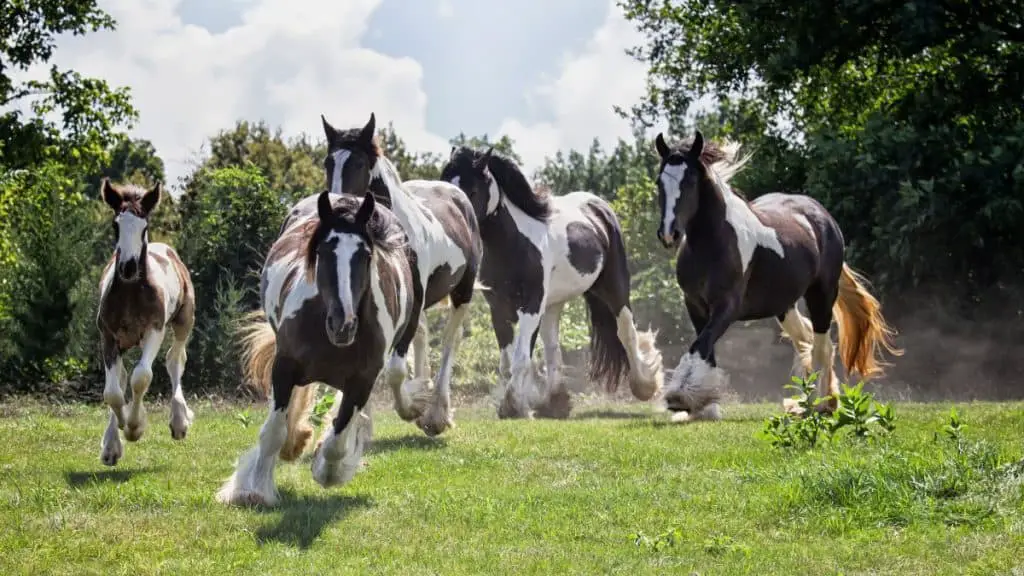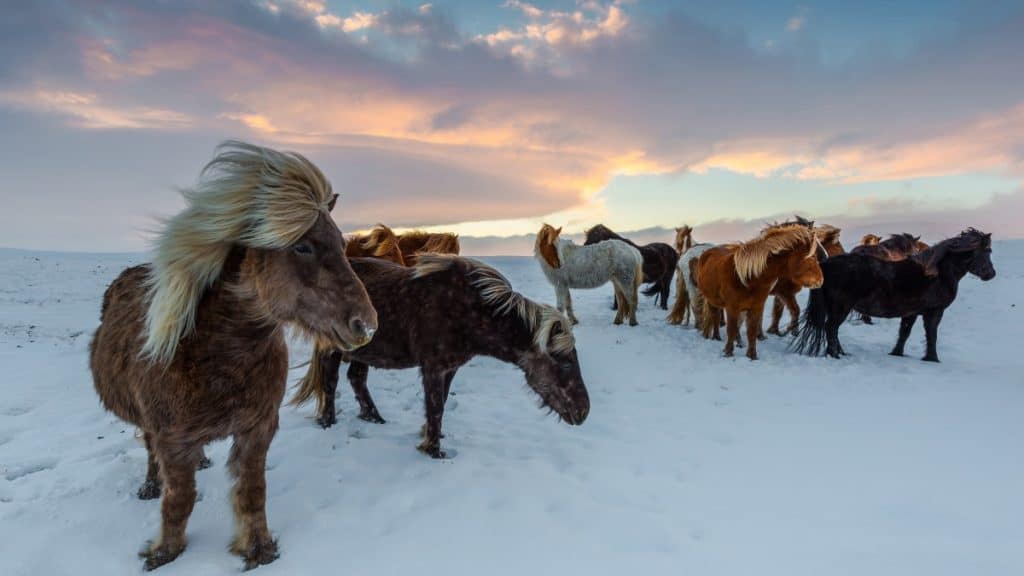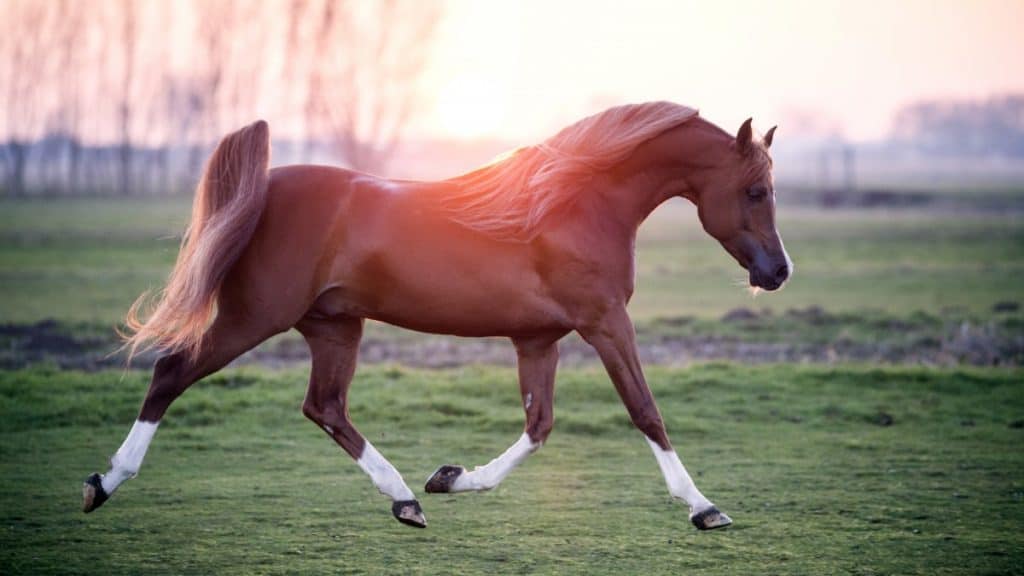Skip To Section
Fluffy horses with straight, long silky hair can look beautiful when groomed properly. There are many examples of horses with long hairs – from wild horses to well-groomed pets, with some unkempt furry horses in the middle.
The following 16 long-haired horse breeds will typically show up, in some order or combination, as among the calmest horse breeds in the world, suitable for beginners and as family pets too.
Lets dive into the list.
1. The Friesian Horse

The Friesian horse is a mixed horse breed that has developed beautiful hair all over – mane, tail, and feathers. The classic black-coated horse is the ideal light horse, formed by breeding draft breeds and gaited horses over the centuries. The original purpose of this Dutch native, namely a light battle horse, still shows in its gait and pose. Their strict breeding standard requires an abundance of hair, which is thick and wavy and requires constant grooming.
2. The Shire

These draft horses from the United Kingdom are hard workers around the farm and elsewhere. Their manes and tails can grow impressively long, though working horses often have them cropped to avoid snagging in equipment and causing injuries.
Their long feathers, which are a natural protection against rough underfoot conditions, are usually left alone – giving this tall and broad horse a stand-out look against a green field.
3. The Morgan Horse

Morgan horses are versatile, equally at ease as a race- or show horse or working on the farm. What distinguishes them are their high neck postures – a look that gets accentuated by their majestic mane and tail hair. Known for being great family horses and providing a smooth ride, their high tail carriage makes them look positively majestic when cantering off on a trail.
4. Gypsy Vanner

Gypsy Vanners (also called Irish or Welsh Cobs) are draft horses found in the British Isles.
The Irish and Welsh breeds, in particular, are known for their calm disposition and willingness to work hard when used on farms.
In addition, they are beautiful horses, compact, colorful, and with beautiful manes, tails, and feathers. Originally bred by the Romani people, these horses love being around people and make great pets.
5. Fell Pony
These black, bay, ash, or brown horses are common in the northern parts of England. They are relatives of the Galloway ponies, a species from the same region that is now extinct. Hard working, having been bred to haul loads over long distances with little fuss, these ponies are also characterized by their extremely furry and fluffy look – which helped keep them comfortable during their extended treks.
6. Iberian Horses (Andalusian And Lusitano)

The P.R.E. (pura raza Española) or Iberian breeds of horses, such as the Andalusian and Lusitano, are bred to standards that require abundant and wavy hair that is usually worn long. Since their import into the Americas and elsewhere, many local horses have been cross-bred with them, producing beautiful, thick hair that can be traced back to their Iberian heritage.
7. Swedish Northern Horse
The Swedish Northern Horse is a relatively smaller size draft horse that is similar to the Icelandic horse in tenacity, work ethic in temperament. Found all over Scandinavia, these horses have developed extremely thick coats and long, thick tails to protect them against the elements. They are used for farm and forest work to this day.
8. The Icelandic Horse

Over the past 1000 years, Icelandic horses have been bred under strict guidelines. While the principal goal was to preserve their tolt gait, the ability of these horses to work tirelessly in harsh winter conditions was matched by natural growths of long and coarse body hair to protect it from the weather. Even the horse’s ears get covered, with good reason – the temperature is often 20+ below in their natural habitats.
9. Dales Pony
The Dales pony was a breed developed and trained to haul mining and other loads over long distances, similar to Fell ponies except slightly smaller in stature. Also black, brown, grey, or ash in color, these easy to get along ponies are another fluffy breed covered with hair that helps keep them warm and protected.
10. Miniature Horse

There are ponies, and then there are really pint-sized horses – the Miniatures, a cross between Welsh and Shetland ponies. They are covered with beautiful locks of hair, which reach ground wards in beautiful locks. Their hair looks even more striking given it can grow as long as any breed but they are noticeably smaller in size, which often leads owners to let their mini horses display their manes, tails, and feathers abundantly.
11. Haflinger
Chestnut brown in color, Haflingers are small horses, typically between 13 and 15 hands. They sport long manes and usually flaxen-colored tails. Resembling a palomino, Haflingers have great strength and are known to be good around humans, including small children. They are often used as workhorses, pulling small wagons. Their hair makes them stand out, both due to the profusion and color.
12. American Saddlebred

American Saddlebred horses are not always hairy all over, but they have an outstanding high carried tail display – something that is characteristic enough that show tails are sometimes tacked on during equestrian events and displays.
The horse’s exceptionally long tail is a sight to behold as it sets off on its energetic high trots. These horses originated from Kentucky in the United States of America.
13. Paso Fino

This Latin American breed of horses developed out of two groups, one from Puerto Rico and one from Colombia – both bred as plantation workers. They show great traces of their Spanish ancestry in terms of luxurious, long hair that is usually allowed to flow naturally according to the standards set for the breed.
The mane and tail really stand out as the Paso Fino horse goes through its many gaits – be it canter, walk, trot or one of its unusual expressions – Paso fino, cordo or largo, or even the occasional fox-trot like trocha (though that is discouraged for purebred Paso Finos).
14. Arabian

Arabians are classic show horses that hold their heads and tail carriage high. Their flowing locks include both manes, which are shown off by the arched neck, and high torso and head, as well as tail hairs, which if left unbobbed are held up like a flag as the consummate showman trots proudly around a field or breaks into a full gallop.
It is not unusual for an Arabian horse’s tail to be left as is, especially in its natural hot, arid habitat where flies are a bother and a long tail acts as a handy swatter.
15. The German Black Forest Horse
Draft horses by nature, the Black Forest Horse is a smaller version of the typical tall and wide large varieties like Clydesdales and Shire horses. The smaller size, typically just over 15 hands tall, is produced through crossbreeding.
Chestnut or bay in color, with flaxen tails, these horses are known for their long manes which were developed as a protection against the cold in their native Black Forest region of Germany.
16. Clydesdales

The classic bay horse, made famous by American beer commercials, is in fact one of the most reliable breeds known to man. Clydesdales were bred to help everywhere – in the fields, as draft horses drawing heavy loads or a horse to ride to battle with. What’s less appreciated sometimes are the beautiful feathers that the typical Clydesdale often sprouts, giving it an elegant look on top of its normal stately carriage.
A few of the breeds mentioned above, the Arabian and Clydesdale in particular, are not necessarily known for their long hair, since other physical attributes overshadow the length of their manes, tails, or feathers.
More Examples Of Long Haired Horses By Type
Horse breeds are often divided into hot, cold, and warm based on their disposition. A more general classification, however, places them into five different classes.
Below, we have briefly described each type of horse, along with examples of horse breeds with long hair within each class.
- Draft horses are tall, big, and strong, bred to drag a multiple of their weight and work hard. Classified as a cold breed due to their calm disposition, there are several breeds that also sport long hair – including Shires, Clydesdales, and Black Forest Horses.
- Light horses are more energetic and known as being agile riding mounts. Most of them have high carriages, which makes their hair stands out all the more. Examples include the Lusitano, Friesian, Paso Fino and the high-stepping breeds like the Arabian.
- Warm breeds are a crossover between the high-energy hot breeds and the cold-blooded horses like the draft horses. They are usually more energetic but have an amiable disposition in many cases, making them suitable as family pets. The ones sporting hair include the Swedish and Morgan horses.
- Gaited horses are similar in disposition to warmbloods and also include some classes of the more temperamental breeds. In general, gaited horses are known for their smooth walks (e.g. trots and tolts) and being comfortable rides. While some Arabians and Paso Finos, for example, maybe gaited, the classic examples of gaited horses with long hair include the Icelandic Horse, American Saddlebred, and the Haflinger.
- Ponies are typically under 5 feet in height and often have short legs, making them comfortable for small-framed riders and a favorite of children. Long haired ponies are plentiful, including Gypsy Vanners, Dell Ponies, Miniatures, and Dales Ponies.
Where Horses Grow Long Hair
When considering horses with long hair, let’s define what that means. All horses by definition have a coat. In most cases, the coats grow shaggier in the winter as protection against the weather, apart from some short-coated breeds.
The owner may also choose to keep the court short if the horse is going to appear at a show, race, or equestrian event. When thinking about breeds with long hair, then, we are considering horses that sport long hair (as defined below) in their natural state.
The hair can sprout as:
Manes And Tails
Even some breeds that are show or racehorses, such as Arabians, may be known for their majestic horse manes and tail carriages. One of the criteria for the horses to be considered hairy is for the tail and mane hair to be long, silky, and untangled – that is, falling straight down.
Feathering
This refers to hair that sprouts from the knees downwards, and often covers the front and rear hooves. With feathered horses, the hair starts at the knees in front and extends near the hocks in the rear, extending over the front of the hooves.
While horses, especially those in the wild, can sport hair anywhere – even furry ears, for example – long-haired horses typically refer to the horse breeds with long manes, tails, and feathering around the legs and feet.
How To Care For Long Haired Horses
While thick, luxurious hair – whether it’s all over or restricted to the mane and tail area – can be beautiful to watch, a certain amount of care is vital to ensure that the animal stays well-groomed and comfortable.
Among the important things to consider is the degree of comfort. A thick coat may be a necessity in cold weather but very uncomfortable in tropical or warm weather. Similarly, the hair must be brushed regularly and untangled to avoid discomfort and even possible infections. Finally, the stalls the horses are kept in must be spacious enough so the horse does not damage its coating against the rough sides that are hemming it in.
The Final Word
The breeds discussed above sport beautiful long hair. Manes, tails, feathers – even horse ears can look pretty when properly groomed. In many cases, these horses are known for their looks as well as their disposition, gait, or other attributes.
Owners have to determine how they want their charges to appear and put some work into it. Under the right circumstances and care, though, these horses will shine.
